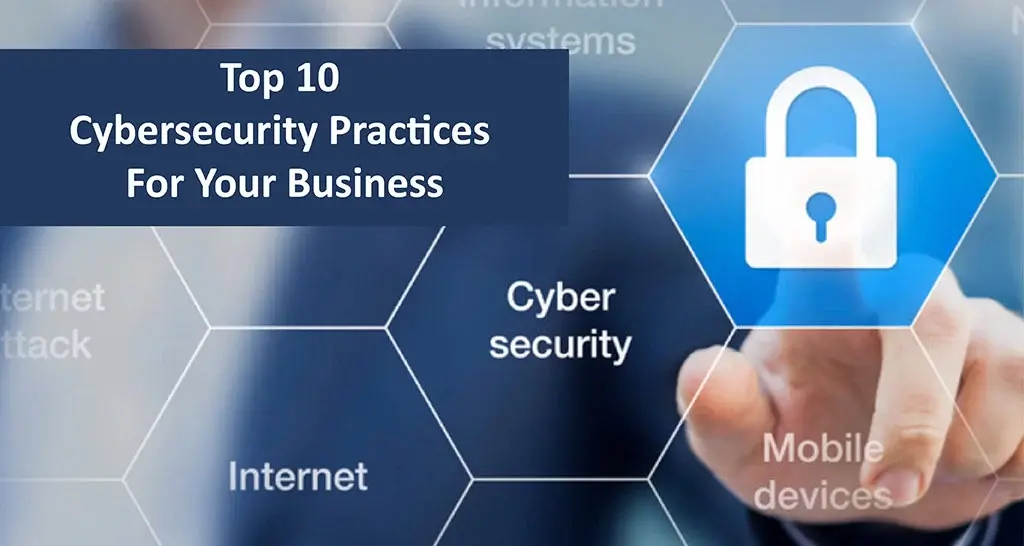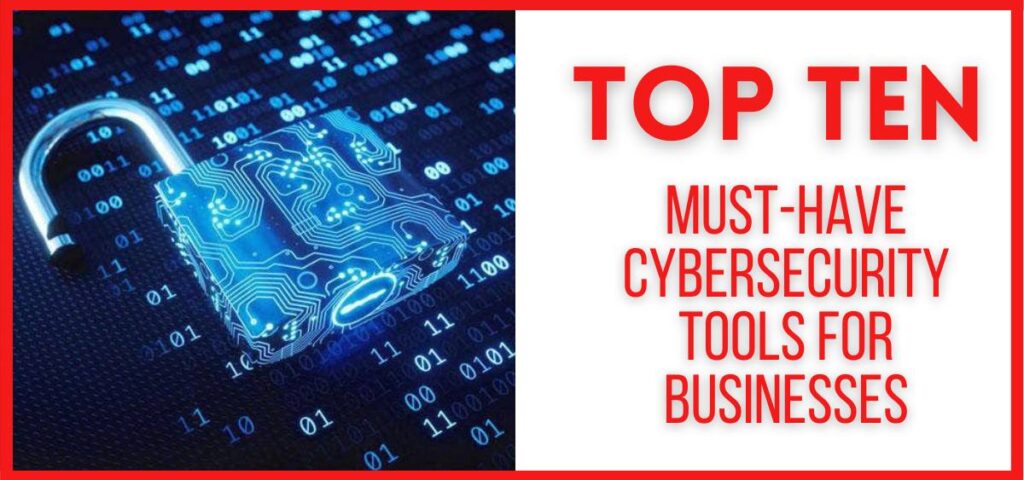In today’s digital age, cyber-attacks are a constant threat to businesses of all sizes. From data breaches to malware infections, these attacks can disrupt operations, damage reputations, and cause significant damage to businesses. Good news? You don’t have to be an unsuspecting target. This blog outlines the top 10 must-have cybersecurity tools for businesses. Explore critical solutions that protect your data, secure your network, and help you navigate the ever-evolving antiviral programs landscape.
Equip your business with a strong digital defense system, create a secure work environment, and be ready to build trust with your customers. Embark on a journey to strengthen your cybersecurity posture and ensure business success in the digital world!
Also read! Top 10 Tips for Implementing a Cybersecurity Mesh Architecture
Why is cyber security important?
In today’s digital world, cyber security is not an option. Cyber attacks are a constant threat and can have devastating effects on businesses. A successful attack can lead to a data breach and expose sensitive customer information such as credit card numbers and personal data. This can lead to expensive fines, reputational damage, and even lawsuits.
Cyber attacks can disrupt operations, cause costly downtime, and hinder customer service. In addition to financial loss, a cyber attack can destroy the trust of customers who rely on you to protect their information. However, a strong cybersecurity posture can help mitigate these risks.
By investing in the right tools and implementing strong security measures, you can stop attacks, minimize damage, and ensure your business runs smoothly. Remember, cybersecurity isn’t just about protecting your data. It’s about building trust, protecting your reputation, and ensuring the long-term success of your business.

Types of cybersecurity tools
Different types of cybersecurity tools are designed to deal with specific threats. Some of the most popular cyber security tools are:
- Public key infrastructure services: PKI services allow you to distribute and identify public cryptographic keys. It will enable computers and people to securely communicate data over the web while verifying the sender’s identity.
- Network security monitoring tools: Network security monitoring tools are used to identify external network threats by identifying and preventing attacks originating from an organization’s intranet.
- Firewalls: Firewalls prevent unauthorized users from accessing your company’s intranet and can be implemented as hardware, software, or a combination of the two.
- Managed detection and response services: Managed Detection and Response (MDR) services are third-party services that help organizations monitor, respond to, and eliminate threats.
- Network defense wireless tools: Wireless network defense tools can significantly improve security by protecting data while maintaining network usability and integrity. Access to the network is controlled using hardware and software technologies.
- Security compliance tools: Security compliance tools scan and assess networks, tools, and processes against regulatory framework requirements. Identify inconsistent activities and security flaws and notify system administrators to take corrective action.
- Encryption tools: Encryption tools decrypt or encrypt data streams at rest or in transit, making the data secure and unreadable to unauthorized persons.
- Web vulnerability scanning tools: Web vulnerability scanning tools continuously monitor web applications for potential security risks, scan your website, and analyze every file and structure of your website to find vulnerabilities in Your web applications.
- Penetration testing: Penetration testing helps identify vulnerabilities in a company’s network that hackers can exploit using existing tactics and tools.
- Packet sniffers: Packet sniffers can collect data for security analysis, identify applications that generate unusual traffic, and identify spikes or reduce network demand while debugging application traffic.
- Antivirus software: Antivirus software helps monitor, block, and remove viruses and other malware from computers and other IT systems. Protect your devices and networks from viruses, rootkits, spyware, keyloggers, botnets, browser hijackers, ransomware, adware, and trojans.
Also read! Top 10 Cybersecurity Threats to Businesses in 2024
Fortress for Your Business: Top 10 Must-Have Cybersecurity Tools
Cyber attacks are a constant threat in today’s digital environment, but there is no need to fear them. With the right tools, your business can become a fortress against them. Encryption tools scramble sensitive data and render it useless even if intercepted. Vulnerability scanners continuously identify weaknesses in your system so you can fix them before attackers can exploit them. Multi-factor authentication adds an extra layer of security by requiring a second verification step and a password. This blog will explore 10 essential cybersecurity tools that act as your digital armor. Imagine that firewalls and endpoint protection software are the first line of defense, protecting your network from unauthorized access and malware.
Also read! Top 10 Challenges of Implementing a Cybersecurity Mesh Architecture
1. Python
Python itself isn’t a stand-alone security tool, but it’s worth having in your cybersecurity arsenal. This versatile programming language also allows businesses to automate repetitive tasks and develop custom security scripts. Imagine simplifying vulnerability scans and generating automated security reports, freeing up your IT team to focus on complex issues.
A wide range of Python libraries provide capabilities for data analysis and threat detection. Although some coding knowledge is required, Python’s beginner-friendly nature makes it an attractive option for building in-house scripting capabilities or integrating with existing cybersecurity tools.
It acts as a force multiplier, extending the reach of your security team and strengthening your overall cybersecurity posture.
2. Kali Linux
Kali Linux may sound scary because it is popular among ethical hackers. However, it can be a valuable tool for businesses. Kali Linux comes preloaded with hundreds of penetration testing tools that allow IT teams (or hired security professionals) to ethically attack their systems and identify vulnerabilities.
Imagine finding and patching vulnerabilities before malicious actors can exploit them. However, please note that Kali Linux is intended for authorized testing only.
When managed properly, it can be a powerful ally, helping businesses identify and fix security gaps before they become serious problems.
3. Pandas
Forget eating bamboo. Pandas, an open-source Python library, allows you to analyze mountains of security data. Imagine filtering firewall logs and user activity like a pro to uncover anomalies that could be a sign of a cyber attack.
Pandas can help you analyze this data and identify suspicious patterns and trends that you might otherwise miss. This data-driven approach improves threat detection and enables teams to make informed security decisions.
4. Forcepoint
Forcepoint provides a comprehensive security platform that goes beyond traditional perimeter defenses. Integrate network security tools such as firewalls with cloud access security brokers (CASB) to ensure secure access to cloud applications.
Imagine having an integrated solution that protects your entire network and even your data in the cloud. This multi-layered approach helps businesses protect sensitive information and prevent data breaches, especially with the growing adoption of cloud-based solutions.
While PowerPoint is a powerful platform, it’s important to evaluate its capabilities against the specific needs of your business and ensure it aligns with your overall cybersecurity strategy.
5. Nexpose
Nexpose is a vulnerability management platform that simplifies the process of identifying and fixing weaknesses in your systems. Imagine having a tool that scans network devices, applications, and operating systems for vulnerabilities and prioritizes them based on severity and exploitability.
Nexpose helps businesses automate vulnerability assessments, generate accurate reports, and stay on top of the evolving threat landscape. This allows IT teams to focus first on patching critical vulnerabilities, reducing the attack surface, and strengthening the overall cybersecurity posture.
Nexpose offers a comprehensive solution, but be sure to check its features and pricing to determine if it fits your specific business needs.
6. Nessus Professional
Nessus Professional is a powerful vulnerability scanner that acts as a digital magnifying glass for IT teams. Imagine a tool that meticulously scans network devices, operating systems, and applications for security vulnerabilities.
Nessus Professional does more than identify vulnerabilities. Prioritization based on severity and exploitability allows teams to focus on applying the most important patches first. This comprehensive solution also provides detailed reports to track vulnerability remediation progress.
Nessus Professional enables businesses to identify and fix security gaps before they are exploited by attackers, ultimately strengthening their overall cybersecurity posture.
7. Metasploit
Metasploit is a popular penetration testing framework used by ethical hackers and security professionals. Although not a direct defense tool, it can be a valuable asset to your company. Metasploit has an extensive library of exploits that allow IT teams (or hired security consultants) to simulate real-world attacks and identify potential weaknesses in their systems.
Imagine testing your defenses against the same tools a malicious attacker might use. By understanding attacker tactics and uncovering vulnerabilities, you can prioritize patching and strengthen your defenses before an actual attack occurs.
Please note that Metasploit is licensed for educational and testing purposes only. When used ethically, it can be a powerful tool for businesses to proactively strengthen their cybersecurity posture.
8. John the Ripper
John the Ripper may look like a pirate, but he is a powerful password-cracking tool. Although not used offensively, businesses can use it defensively. Imagine testing the strength of an employee’s password by mimicking an attacker’s methods.
John the Ripper reveals weak passwords that are easy to guess, allowing you to enforce stronger password policies and improve overall account security.
Remember, strong passwords are a key defense against cyber-attacks, and a cracker can help you identify vulnerabilities before they are exploited. However, it is important to use this tool ethically and only on approved systems.
9. Wireshark
Although Wireshark is not a traditional security tool, it is an invaluable asset for network troubleshooting and security analysis. Imagine acting like a digital detective, capturing and analyzing network traffic flowing across your network. Wireshark lets you detect suspicious activity, malware communications, or unauthorized access attempts.
Security professionals can use Wireshark to investigate potential breaches, diagnose network problems, and even monitor vulnerabilities that can be exploited. However, Wireshark requires technical expertise to work effectively. For businesses that do not have in-house security analysts, managed security service providers (MSSPs) can use Wireshark as part of their broader security monitoring services.
10. Splunk
At Splunk, we embrace the challenge of turning the often complex mountains of security data into actionable insights. Imagine being able to filter logs from firewalls, servers, and user activity in one place.
Splunk collects, indexes, and analyzes this data to help identify suspicious patterns and potential security incidents. It enables your team to investigate threats faster, correlate events from multiple sources, and make data-driven decisions to protect your business.
Splunk offers a powerful platform, but there is a learning curve. When evaluating Splunk as a security tool for your business, consider its technical expertise and desired features.
FAQs: Cybersecurity Tools for Businesses
Q. What are the most common cybersecurity threats businesses face?
- Data breaches: Hackers steal sensitive customer or company data.
- Malware attacks: Malicious software that can disrupt operations or steal information.
- Phishing scams: Deceptive emails or messages tricking employees into revealing sensitive information.
- Ransomware attacks: Hackers encrypt your data and demand a ransom to unlock it.
Q. Why should my business invest in cybersecurity tools?
- Protects your data: Prevents costly data breaches and safeguards sensitive information.
- Maintains business continuity: Minimizes downtime caused by cyberattacks.
- Builds customer trust: Demonstrates your commitment to protecting customer data.
- Reduces legal risks: Helps you comply with data privacy regulations.
Q. What are the different types of cybersecurity tools available?
- Antivirus and Anti-malware software: Protects devices from malicious programs.
- Firewalls: Monitors incoming and outgoing network traffic, filtering out suspicious activity.
- Email Security: Protects against phishing scams and malware in emails.
- Data encryption tools: Scrambles sensitive data for secure storage and transmission.
- Network security monitoring tools: Continuously scan your network for suspicious activity.
- Vulnerability scanners: Identify weaknesses in your systems that hackers might exploit.
- Multi-factor authentication: This adds an extra layer of security by requiring a second verification step beyond just a password.
Q. What is Cisco Cyber Security?
Cyber security is the act of protecting systems, networks, and applications against digital attacks. These cyber-attacks are usually carried out to access, change or destroy sensitive information. Extorting users through ransomware. or disrupt normal business processes.
Q. What is cyber security?
Cybersecurity is the use of technology, controls, and processes to protect digital networks, devices, and data from unauthorized access and unwanted activity by malicious actors. This includes the use of various types of cyber security to ensure the confidentiality, integrity, and availability of information.
Conclusion: The Final Words
In today’s digital age, where cyber threats are becoming increasingly sophisticated, investing in robust Cybersecurity Tools for Businesses is no longer an option but a necessity. The tools we’ve explored in this list offer a comprehensive solution to safeguard your business from various cyberattacks. From advanced endpoint protection to secure email gateways, these tools can significantly enhance your organization’s security posture.
However, it’s crucial to remember that Cybersecurity Tools for Businesses are just one piece of the puzzle. A robust cybersecurity strategy requires a multi-layered approach, including employee training, regular security audits, and incident response planning. By combining these elements with the right Cybersecurity Tools for Businesses, you can effectively protect your valuable assets and maintain business continuity.


































